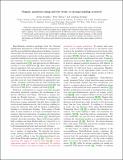Files in this item
Organic polariton lasing and the weak- to strong-coupling crossover
Item metadata
| dc.contributor.author | Strashko, Artem | |
| dc.contributor.author | Kirton, Peter | |
| dc.contributor.author | Keeling, Jonathan | |
| dc.date.accessioned | 2018-10-24T10:30:11Z | |
| dc.date.available | 2018-10-24T10:30:11Z | |
| dc.date.issued | 2018-11-09 | |
| dc.identifier | 256290813 | |
| dc.identifier | 927f0049-97f6-4775-a35f-203ba7c3de02 | |
| dc.identifier | 85056421019 | |
| dc.identifier | 000449791600009 | |
| dc.identifier.citation | Strashko , A , Kirton , P & Keeling , J 2018 , ' Organic polariton lasing and the weak- to strong-coupling crossover ' , Physical Review Letters , vol. 121 , no. 19 , 193601 . https://doi.org/10.1103/PhysRevLett.121.193601 | en |
| dc.identifier.issn | 0031-9007 | |
| dc.identifier.other | ArXiv: http://arxiv.org/abs/1808.07683v1 | |
| dc.identifier.other | ORCID: /0000-0002-4283-552X/work/50743968 | |
| dc.identifier.other | ORCID: /0000-0001-8082-1826/work/50743999 | |
| dc.identifier.uri | https://hdl.handle.net/10023/16315 | |
| dc.description.abstract | Following experimental realizations of room temperature polariton lasing with organic molecules, we present a microscopic model that allows us to explore the crossover from weak to strong matter-light coupling. We consider a non-equilibrium Dicke-Holstein model, including both strong coupling to vibrational modes and strong matter-light coupling, providing the phase diagram of this model in the thermodynamic limit. We discuss the mechanism of polariton lasing, uncovering a process of self-tuning, and identify the relation and distinction between regular dye lasers and organic polariton lasers. | |
| dc.format.extent | 6 | |
| dc.format.extent | 1945968 | |
| dc.language.iso | eng | |
| dc.relation.ispartof | Physical Review Letters | en |
| dc.rights | © 2018, American Physical Society. This work has been made available online in accordance with the publisher’s policies. This is the author created accepted version manuscript following peer review and as such may differ slightly from the final published version. The final published version of this work is available at https://doi.org/10.1103/PhysRevLett.121.193601 | en |
| dc.subject | QC Physics | en |
| dc.subject | TK Electrical engineering. Electronics Nuclear engineering | en |
| dc.subject | NDAS | en |
| dc.subject.lcc | QC | en |
| dc.subject.lcc | TK | en |
| dc.title | Organic polariton lasing and the weak- to strong-coupling crossover | en |
| dc.type | Journal article | en |
| dc.contributor.sponsor | EPSRC | en |
| dc.contributor.sponsor | EPSRC | en |
| dc.contributor.sponsor | EPSRC | en |
| dc.contributor.institution | University of St Andrews.School of Physics and Astronomy | en |
| dc.contributor.institution | University of St Andrews.Condensed Matter Physics | en |
| dc.identifier.doi | 10.1103/PhysRevLett.121.193601 | |
| dc.description.status | Peer reviewed | en |
| dc.identifier.grantnumber | EP/M025330/1 | en |
| dc.identifier.grantnumber | EP/M010910/1 | en |
| dc.identifier.grantnumber | EP/L015110/1 | en |
This item appears in the following Collection(s)
Items in the St Andrews Research Repository are protected by copyright, with all rights reserved, unless otherwise indicated.

